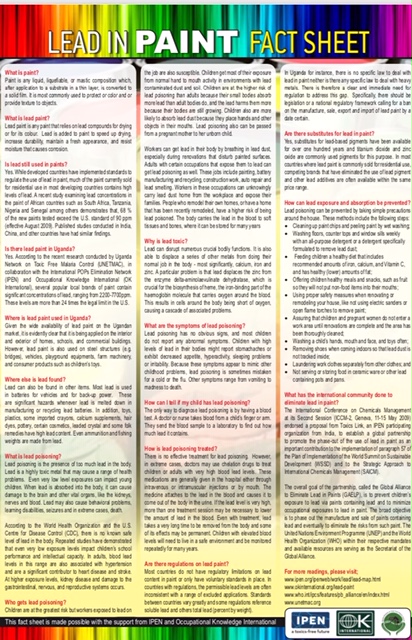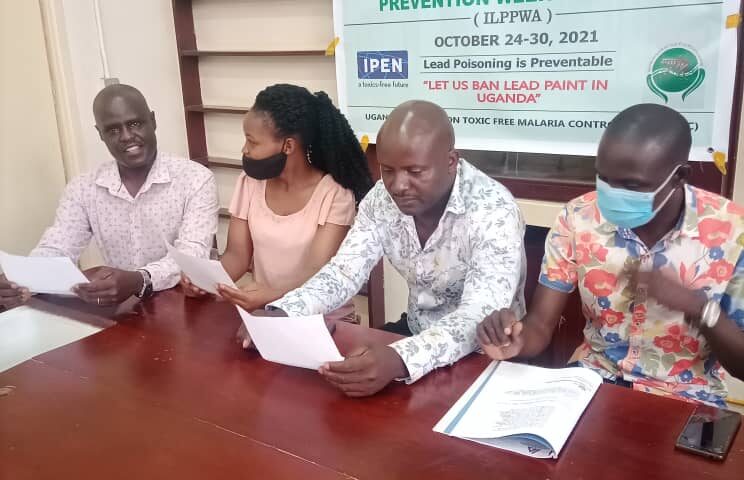By Andrew Irumba
Kampala: As Uganda joins the rest of the world to commemorate the International Lead Poisoning Prevention Week of Action (ILPPWA) which for the case of this year runs from 24th -30th October 2021, health and environmental experts have warned that Ugandan children risk getting the problem of permanent brain damage if they continue getting exposed to lead paint.

While addressing the media in Kampala this week, Dr. Wasswa John, the Head of the Chemistry Department at Makerere University revealed that lead is a highly toxic metal that causes a range of health problems if one is exposed to it.
Dr. Wasswa noted that when a lead is absorbed into someone’s body, it can cause damage to the brain and other vital organs such as kidneys and can cause diseases such as hypertension, heart disease, nerves and blood clot as well as stroke in adults and that even at very low-level exposures, lead can negatively impact young children by causing behavioural problems, learning disabilities, seizures and in extreme cases, death. ”Lead poisoning usually occurs over a period of months or years,” he adds.
Dr. Wasswa further reveals that according to the World Health Organization (WHO) and the U.S. Centre for Disease Control (CDC), there is no known safe level of lead in the body. Children are at the greatest risk but workers exposed to lead on the job are also susceptible. He further clarified that children get most of their exposure from normal hand to mouth activity in environments with lead-contaminated dust and soil and that lead poisoning also can be passed from a pregnant mother to her unborn child.
While addressing the same media, Mr. Muyambi Ellady, the Secretary-General for Uganda Network on Toxic Free Malaria Control (UNETMAC), a Ugandan national network of NGOs that strives to achieve a malaria-free world as a toxic-free future revealed that many paint manufacturers, including some of the world’s largest transnational paint companies, continue to produce and sell lead paints which they classify as “industrial paints” and that these paints frequently contain extremely high lead concentrations (up to 30%) but are still sold for consumer use and are found on metal playground equipment, and on household and school metal fences, windows, and doors.
Mr. Muyambi further noted that according to studies provided by the International POPs Elimination Network (IPEN), an international organization that promotes safe and sustainable chemical use, lead paints used for cars, road markings, ships, bridges, and steel structures are a significant source of environmental contamination and that some countries with lead paint laws have been unable to stop all lead paint imports and stop all domestic manufacture of lead paints.
As part of her effort to compliment other partners in the promotion of sound management of chemicals (SMC) in Uganda and realizing the benefits of the Global Alliance to Eliminate Lead in Paints (GAELP) which is to prevent children’s exposure to lead via paints containing lead and to minimize occupational exposures to lead in paint as well as its broad objective which is to phase out the manufacture and sale of paints containing lead and eventually to eliminate the risks from such paint, the Uganda Network on Toxic Free Malaria Control (UNETMAC) is hereby requesting the Ugandan government to promulgate/enact a law that regulates lead content and specifically lead paint because alternatives to lead paint are available and affordable and that lead used in so-called industrial paint must be prohibited.
Noted that in 2002, the Johannesburg World Summit on Sustainable Development called for the phase-out of lead-based paints and in 2009, the International Conference on Chemicals Management (ICCM) asked the United Nations Environment Programme (UNEP) and the World Health Organization (WHO) to establish a global partnership to promote phasing out lead in paint and as such, the United Nations Environmental Assembly and the World Health Assembly have both called upon governments to establish national controls on lead in paints.
Also noted was the fact that very few countries in Africa regulate the lead content in decorative paints. South Africa has adopted binding, regulatory controls limiting lead in decorative paint to 600 ppm.
Cameroon enacted a regulation in September 2017 banning the manufacture, importation and marketing of paints containing more than a total of 90 ppm lead.
Here Is UNETMAC Fact Sheet About Lead In Paint
Legally binding standards based on a total 90ppm maximum limit on the lead content of paint are also underway in Ethiopia, Kenya and Tanzania. In May 2016, the East African Community (EAC) adopted a 100ppm lead limit in new standards for various types of paint, as measured by the migration of lead from the paint. This is legally binding for its six-member states (Burundi, Kenya, Rwanda, South Sudan, Tanzania and Uganda). Zimbabwe and Algeria have regulations limiting the lead content of paint, but the standards in these countries—10,000 ppm in Zimbabwe and 5,000 ppm in Algeria—are not health-protective.
Efforts have been made and are continuing to be made aimed at using a variety of ingredients in place of lead. Different brands use their formula to create the colors they want, using both organic and inorganic pigments. There is no standard conversion for lead pigments, so companies focus on quality before they manipulate the color. The most common replication of the white-lead pigment is titanium dioxide. Titanium dioxide has such low toxicity that it’s added to a wide variety of food. Also, it’s more useful in creating the desired color as the opacity of titanium oxide is superior to that of lead.





